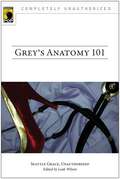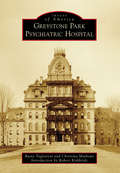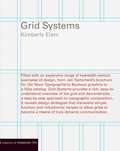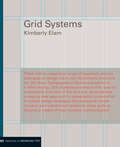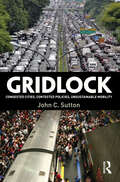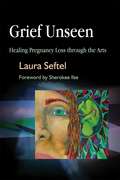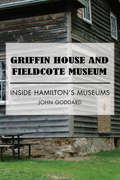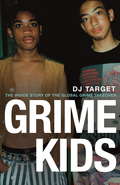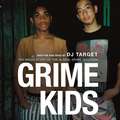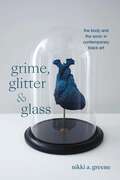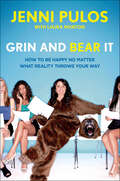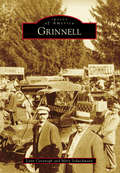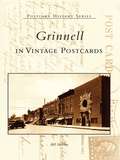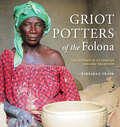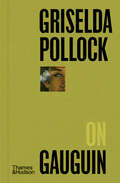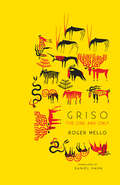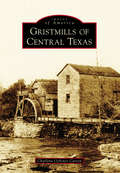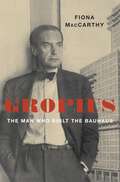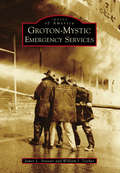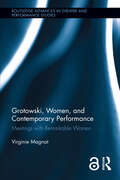- Table View
- List View
Grey's Anatomy 101: Seattle Grace, Unauthorized
by Leah WilsonThe 2005-2006 season's smash hit Grey's Anatomy swiftly eclipsed its Desperate Housewives lead-in, in ratings, in critical claim and in vocal viewer enthusiasm. What could have been just another hospital drama is elevated by sharp, clever writing, strong female characters and a stellar ensemble cast of multi-ethnic actors. With 20+ million viewers tuning in every week, Grey's Anatomy was the new must-see television show of the year. From lighthearted relationship speculations to analyses of deeper themes, Grey's Anatomy 101 gives new perspectives on all facets of the series. If Addison hadn't showed up, would Meredith and Derek have stayed together? How is Grey's Anatomy the first real 21st century show? Why is everything in Grey's Anatomy so, well, gray? And what would Nietzsche have to say about George O'Malley? The writers in Grey's Anatomy 101 give fans more of their favorite television show, delivering writing as smart, as funny, and as earnest as the show they love.
Greystone Park Psychiatric Hospital (Images of America)
by Christina Mathews Robert Kirkbride Rusty TagliareniThe Greystone Park Psychiatric Hospital was more than a building; it embodied an entire era of uniquely American history, from the unparalleled humanitarian efforts of Dorothea Dix to the revolutionary architectural concepts of Thomas Story Kirkbride. After well over a century of service, Greystone was left abandoned in 2008. From the time it closed until its demolition in 2015, Greystone became the focal point of a passionate preservation effort that drew national attention and served to spark the public's interest in historical asylum preservation. Many of the images contained in this book were rescued from the basement of Greystone in 2002 and have never been seen by the public. They appear courtesy of the Morris Plains Museum and its staff, who spent many hours digitally archiving the photographs so that future generations may better know Greystone's history.
Grid Systems: Principles of Organizing Type
by Kimberly ElamFilled with extensive research and more than 100 informative examples from the Bauhaus to Nike ads, Grid Systems provides a rich, easy-to-understand overview and demonstrates a step-by-step approach to typographic composition. It suggests design strategies that transcend simple function and reductionist recipes to allow grids to become a means of truly dynamic communication. Any designer, educator, or student will benefit greatly from this elegant slim book, chock-a-block full of colorful examples, helpful vellum overlays, and Elam's insightful analysis.
Grid Systems: Principles of Organizing Type
by Kimberly ElamAlthough grid systems are the foundation for almost all typographic design, they are often associated with rigid, formulaic solutions. However, the belief that all great design is nonetheless based on grid systems (even if only subverted ones) suggests that few designers truly understand the complexities and potential riches of grid composition.
Grid/ Street/ Place: Essential Elements of Sustainable Urban Districts
by Nathan CherryToday's urban resident is seeking a more flexible, sustainable environment-representing a unique, diverse, vibrant, and responsible way of living-as an alternative to the typical development patterns of suburban and semi-urban sprawl. Can urban design help create this type of sustainable urbanism? Grid Street Place presents a unique approach to understanding urban design through scientific, empirical research. The authors examined more than 100 successful projects throughout North America to identify differences and commonalities, and they discovered universal elements that characterize sustainable urban districts. By applying these essential elements, designers and developers can recreate and extend the experience of successful places to their communities. Myriad plans, sections, diagrams, and charts illustrate how each district work-at an extremely detailed level. Concrete examples, as opposed to generalities, make Grid Street Place a must-read for anyone interested in the working strategies of urban design.
Gridlock: Congested Cities, Contested Policies, Unsustainable Mobility
by John C. SuttonCities across the world are facing unprecedented challenges in traffic management and transit congestion while coping with growing populations and mobility aspirations; existing policies that aim to tackle congestion and create more sustainable transport futures offer only weak remedies. In Gridlock: Congested Cities, Contested Policies, Unsustainable Mobility, transport consultant John C. Sutton explores how two competing discourses in transport policy and planning practice – convivial and competitive ideologies – lead to contradictory solutions and a gridlock in policy as well as on transport systems. Gridlock examines current transport and mobility in a geographical, social, political-economy and technological context. The challenges of rising congestion are highlighted through case studies from the UK, the USA, and OECD countries. Sutton offers readers a vision of a sustainable mobility future through the concept of mobility management, combining mobile communication and information technology with logistics to match travel demand to the capacity of transport systems. Essential reading for transport professionals and students of transportation planning and policy, Gridlock offers a unique manifesto for sustainable mobility settlement, addressing the pressing problems of growing populations and congestion while looking ahead to a more sustainable future.
Grief Unseen: Healing Pregnancy Loss through the Arts
by Laura SeftelAt least one in five pregnancies ends in miscarriage, yet pregnancy loss remains a taboo topic and effective aftercare is rarely available for those who have experienced it. Grief Unseen explains the different kinds of childbearing losses, such as failed fertility treatment, ectopic pregnancy, and stillbirth, and explores their emotional impact on women and their partners, and the process of healing. An established art therapist and mental health counselor, Laura Seftel shares her own experiences of miscarriage and recovery, and describes the use of art and ritual as a response to loss in traditional and modern cultures. She presents a rich variety of artists who have explored pregnancy loss in their work, including Frida Kahlo, Judy Chicago, and Tori Amos, and shows how people with no previous artistic experience can generate creative responses as part of the healing process. The book includes step-by-step exercises in guided imagery, poetry, visual art, journaling, and creating rituals. This accessible, positive resource will be useful to practitioners in the fields of medicine, mental health, art therapy, and counseling, as well as women and families who have suffered pregnancy loss.
Griffin House and Fieldcote Museum: Inside Hamilton's Museums
by John GoddardInside Hamilton’s Museums helps to satisfy a growing curiosity about Canada’s steel capital as it evolves into a post-industrial city and cultural destination. In this special excerpt we visit two sites, Griffin House and the Fieldcote Memorial Park and Museum. Griffin House honours one of Ancaster's earliest black settlers, Enerals Griffin, and pays tribute to the black slaves from the United States who fled to freedom in Upper Canada. Fieldcote Museum was built as private home and now functions as a gallery for exhibitions alternating between local history and the visual arts. John Goddard takes us on a detailed tour of the historic homes and gardens, providing fascinating historical background and insight.
Grill it with Levi: 101 Reggae Recipes for Sunshine and Soul
by Levi RootsHe’s back and hotter than ever! Levi is getting back to his Roots with over 100 Caribbean- and sunshine-infused recipes for the barbecue and grill. From his first appearance – guitar in hand – in the Dragons’ Den, Levi’s winning personality and sunny food has brought a taste of Caribbean joy to our dinner plates. In this book, Levi gets back to his Jamaican influences with over 100 recipes to conjure up those lazy, hazy summer days. He cooks up feasts for the barbecue and grill with fresh, healthy ingredients that have been given his special West Indian twist – think Chicken with Molasses, Sugar and Lime; Calypso Burgers with Tropical Salsa; and Jamaican Snapper Parcels – all washed down with a Sunshine Smoothie.Grill it with Levi brings together all Levi's passions: healthy, quick and flavourful food, cooking outside and eating with friends. All the recipes can be cooked on a barbecue – or, if the weather's not so sunny – you can bring the summer inside.Shake that Reggae Reggae Sauce and let’s get some soul back into our food!
Grime Kids: The Inside Story of the Global Grime Takeover
by DJ TargetAn explosive insider account of grime, from subculture to international phenomenon. *****A group of kids in the 2000s had a dream to make their voice heard - and this book documents their seminal impact on today's pop culture.DJ Target grew up in Bow under the shadow of Canary Wharf, with money looming close on the skyline. The 'Godfather of Grime' Wiley and Dizzee Rascal first met each other in his bedroom. They were all just grime kids on the block back then, and didn't realise they were to become pioneers of an international music revolution. A movement that permeates deep into British culture and beyond. Household names were borne out of those housing estates, and the music industry now jumps to the beat of their gritty reality rather than the tune of glossy aspiration. Grime has shaken the world and Target is revealing its explosive and expansive journey in full, using his own unique insight and drawing on the input of grime's greatest names.
Grime Kids: The Inside Story of the Global Grime Takeover
by DJ TargetFor fans of Wiley, Dizzee Rascal and Stormzy, Grime Kids is the definitive inside story of Grime.'An essential read for anyone with the slightest interest in the birth of Grime' The Wire'Sharp and nostalgic' The ObserverA group of kids in the 90s had a dream to make their voice heard - and this book documents their seminal impact on today's pop culture. DJ Target grew up in Bow under the shadow of Canary Wharf, with money looming close on the skyline. The 'Godfather of Grime' Wiley and Dizzee Rascal first met each other in his bedroom. They were all just grime kids on the block back then, and didn't realise they were to become pioneers of an international music revolution. A movement that permeates deep into British culture and beyond. Household names were borne out of those housing estates, and the music industry now jumps to the beat of their gritty reality rather than the tune of glossy aspiration. Grime has shaken the world and Target is revealing its explosive and expansive journey in full, using his own unique insight and drawing on the input of grime's greatest names.What readers are saying about Grime Kids:'Fantastic depiction of the inception of a genre that has spanned the millennium''Brilliant insight in to grim music from one of the pioneers of the scene''This book really sums up the feeling of being a DJ perfectly'
Grime Kids: The Inside Story of the Global Grime Takeover
by Dj TargetAn explosive insider account of grime, from subculture to international phenomenon. *****A group of kids in the 2000s had a dream to make their voice heard - and this book documents their seminal impact on today's pop culture.DJ Target grew up in Bow under the shadow of Canary Wharf, with money looming close on the skyline. The 'Godfather of Grime' Wiley and Dizzee Rascal first met each other in his bedroom. They were all just grime kids on the block back then, and didn't realise they were to become pioneers of an international music revolution. A movement that permeates deep into British culture and beyond. Household names were borne out of those housing estates, and the music industry now jumps to the beat of their gritty reality rather than the tune of glossy aspiration. Grime has shaken the world and Target is revealing its explosive and expansive journey in full, using his own unique insight and drawing on the input of grime's greatest names.
Grime, Glitter, and Glass: The Body and the Sonic in Contemporary Black Art (The Visual Arts of Africa and its Diasporas)
by Nikki A. GreeneIn Grime, Glitter, and Glass, Nikki A. Greene examines how contemporary Black visual artists use sonic elements to refigure the formal and philosophical developments of Black art and culture. Focusing on the multimedia art of Renée Stout, Radcliffe Bailey, and María Magdalena Campos-Pons, Greene traces the intersection of the visual’s sonic possibilities with the Black body’s physical, representational, and metaphorical use in art. She employs her concept of “visual aesthetic musicality” to interpret Black visual art by examining the musical genres of jazz and rap, along with the often-overlooked innovations of funk and rumba, within art historiography. From Bailey’s use of multilayered surfaces of glitter, mud, and recycled materials to meditate on Sun Ra’s Afrofuturism to Stout’s life-size cast of her own body that recalls funk musician Betty Davis to Campos-Pons’s performative and sculptural references to sugar that resonate with the legacy of Celia Cruz, Greene outlines how these artists use mediums such as molded glass sculptures, viscous wet plaster, and dazzling mannequin heads to enhance the manifestations of Black identity. By foregrounding the sonic elements of their work, Greene demonstrates that these artists use sound to make themselves legible, recognizable, and audible.
Grin and Bear It: How to Be Happy No Matter What Reality Throws Your Way
by Laura Morton Jenni PulosJenni Pulos, from Bravo's Flipping Out and Interior Therapy, pens a charming memoir-advice book on how to survive (and thrive) in any situationJenni Pulos has specialized in a lifetime of disappointments. She's been publicly humiliated, dumped by her spouse on national television, told she'd never make it in Hollywood, encouraged by her family with inspiring questions like, "when are you getting a real job?" and has not only survived but thrived as a result. Despite her struggles and setbacks, Jenni has gone from a "wannabe" aspiring actress and comedian to becoming one of Bravo's most beloved personalities. With hilarious reality meets insanity anecdotes from her life and career, Jenni writes candidly on how to go from victim to victor . . . most of the time. Her book is more of an advice how-not-to story that includes: * Jenni's top ten tested and proven ways to fail forward * How she turned her negative self-talk into positive self-beliefs * How Jenni handles people who didn't want her to succeed * How she stopped fretting over things she didn't have control over * How she found her self-worth and finally found the love she never thought she'd haveGrin and Bear It is the spark we all need to ignite our passion, to get out there and be positive, find the funny in life, to be present, and learn how to be happy no matter what reality throws your way.
Grind a Blade the R.J. Martin Way: Knife Sharpening Techniques & Tips
by Joe KertzmanAuthor R.J. Martin, whose knives are some of the most popular and sought-after in the industry, instructs on flat- and double-hollow-grinding knife blades. Martin been featured in BLADE® Magazine with increasing frequency, and here's your chance to learn his methods for blade grinding. You won't be disappointed.
Grinnell
by Mary Schuchmann Lynn CavanaghA passion for education, opposition to slavery, and yearning for a moral life led Josiah B. Grinnell and his band of like-minded New Englanders to establish a town and a college on the Iowa prairie in 1854. Over the years, a remarkable number of dreamers and doers from all walks of life have emerged from Grinnell, including pioneer aviator Billy Robinson; Harry Hopkins, advisor to Pres. Franklin D. Roosevelt; and Robert Noyce, cofounder of Intel Corporation. Today, Grinnell is a distinctive blend of urban and rural culture that has been marked by the idealism of its beginnings, molded by the surrounding agricultural economy, and shaped by prestigious Grinnell College. Proudly known as the "Jewel of the Prairie," Grinnell is recognized in the National Register of Historic Places with two historic districts and 15 individual buildings. The Merchants National Bank designed by Louis Sullivan is a National Historic Landmark.
Grinnell in Vintage Postcards
by Bill MennerFrom an abolitionist hotbed to the home of a prestigious liberal arts college, Grinnell, Iowa, is known across the country as a "jewel of the prairie." Originally conceived as a Congregationalist utopia, Grinnell developed a reputation as a highly-educated community with a wealth of incredible architecture. It was also a turn-of-the-century industrial hub, despite a population of less than 5,000, where buggies, early automobiles, and gloves were made.The historic postcards in this book recall a community on the verge of transition, from a small agriculture-based town on the prairie to a thriving center of commerce and higher education. They provide a remarkable glimpse of the buildings that make up what is now a "Historic Commercial District" on the National Register of Historic Places. Still others are visual reminders of great buildings-both in the community and on the Grinnell College campus-that now exist only in memory.
Griot Potters of the Folona: The History of an African Ceramic Tradition
by Barbara E. FrankGriot Potters of the Folona reconstructs the past of a particular group of West African women potters using evidence found in their artistry and techniques. The potters of the Folona region of southeastern Mali serve a diverse clientele and firing thousands of pots weekly during the height of the dry season. Although they identify themselves as Mande, the unique styles and types of objects the Folona women make, and more importantly, the way they form and fire them, are fundamentally different from Mande potters to the north and west.Through a brilliant comparative analysis of pottery production methods across the region, especially how the pots are formed and the way the techniques are taught by mothers to daughters, Barbara Frank concludes that the mothers of the potters of the Folona very likely came from the south and east, marrying Mande griots (West African leatherworkers who are better known as storytellers or musicians), as they made their way south in search of clientele as early as the 14th or 15th century CE. While the women may have nominally given up their mothers' identities through marriage, over the generations the potters preserved their maternal heritage through their technological style, passing this knowledge on to their daughters, and thus transforming the very nature of what it means to be a Mande griot. This is a story of resilience and the continuity of cultural heritage in the hands of women.
Griselda Pollock on Gauguin (Pocket Perspectives #6)
by Griselda PollockGriselda Pollock, feminist art historian and longstanding advocate of gender and racial inclusivity, unpacks the racist, sexist, and imperialist underpinnings of works created by Gauguin and others as they competed for preeminence in the European artistic avant-garde of the 1880s and '90s. Surprising, questioning, challenging, enriching: the Pocket Perspectives series presents timeless works by writers and thinkers who have shaped the conversation across the arts, visual culture, and history. Celebrating the undiminished vitality of their ideas today, these covetable and collectable little books embody the best of Thames & Hudson.
Griso: The One and Only
by Roger MelloA unicorn searches for others just like him in this vibrant and shapeshifting tale by Batchelder-Honor author and illustrator, Roger MelloThe last of his kind, Griso travels the world searching for unicorn companions. He asks beetles, chameleons, and buffalos if they&’ve seen any mythical creatures like him, and all send him on his way saying, &“Neither here nor at the edge of the world.&” Griso gallops across plains, marshes, and mountains, he trots into the sunset and chats with fearsome narwals by the sea. On each spread, we see Griso rendered in a new artistic style, portrayed as a shadowy cave painting, a chivalrous medieval stead, or lost along a mind-bending surrealist horizon. Griso, the Unique introduces young readers to artistic movements spanning the 7th to 18th century, leaping across time and color with the flip of a page. In Daniel Hahn&’s exquisite translation, Griso, the Unique opens the doors to a world of African painting, Tang Dynasty murals, medieval tapestries, and art hidden beneath Egyptian pyramids. A song of color, time, expression, and a fantastical search for belonging by Brazilian visionary, Roger Mello.
Gristmills of Central Texas (Images of America)
by Charlene Ochsner CarsonGristmills were once commonplace in Texas. There was hardly a river, a creek, or a stream without one. The purpose of the gristmill was to grind wheat into flour and corn into meal. Prior to the water-powered gristmill, grinding was a tedious, time-consuming task that was usually performed by hand using some type of mortar and pestle. When a gristmill began operating in an area, settlers from near and far traveled to the mill to have their grain ground. The gathering of these settlers and farmers at the mill was the beginning of many settlements that grew into the Texas towns of today. Many of these picturesque settings have become major tourist destinations.
Gropius: The Man Who Built the Bauhaus
by Fiona MacCarthyFiona MacCarthy challenges the image of Walter Gropius as a doctrinaire architectural rationalist, bringing out the vision and courage that carried him through a politically hostile age. Approaching the Bauhaus founder from all angles, she offers a poignant personal story, one that reexamines the urges that drove Euro-American modernism as a whole.
Grosse Ile
by Grosse Ile Historical SocietyGrosse Ile Township today is made up of a dozen islands in the Detroit River. The largest island was given the name Grosse Ile by early French explorerswho found it being used by the Native American tribes as a fishing and hunting ground. In 1776, Detroit merchants William and Alexander Macomb purchased Grosse Ile from the Potawatomi Indians and, to help establish their ownership rights, built a home and a gristmill and secured tenant farmers to till the land. Later acreage was sold off and settlement began in earnest, although it remainedlargely an agricultural community. The railroad came to Grosse Ile in the 1880s and attracted both visitors and new residents. Hotels sprang up to accommodate summer visitors who were drawn to Grosse Ile by its healthful climate, natural beauty, and opportunities for outdoor recreation. Today Grosse Ile is home to more than 11,000 residents who have come here to enjoy many of those same unique qualities--all in close proximity to a large metropolitan area.
Groton-Mystic Emergency Services (Images of America)
by William J. Tischer James L. StreeterEstablished in 1705, the town of Groton is geographically located between the Thames and Mystic Rivers in the southeastern corner of Connecticut. The town is comprised of eight separate subdivision communities that are referred to as fire districts. Groton is also the home to a large naval submarine base, a small general aviation airport, and several major industrial facilities, including the Electric Boat Corporation and Pfizer, Inc. The Mystic fire district is recognized for its historical maritime museums and facilities and plays host to thousands of tourists each year. At the present time, Groton and Mystic are provided emergency services by 13 fire departments, three police departments, two ambulance associations, one paramedic response unit, and one central dispatch operation.
Grotowski, Women, and Contemporary Performance: Meetings with Remarkable Women (Routledge Advances in Theatre & Performance Studies)
by Virginie MagnatAs the first examination of women's foremost contributions to Jerzy Grotowski's cross-cultural investigation of performance, this book complements and broadens existing literature by offering a more diverse and inclusive re-assessment of Grotowski's legacy, thereby probing its significance for contemporary performance practice and research. Although the particularly strenuous physical training emblematic of Grotowski's approach is not gender specific, it has historically been associated with a masculine conception of the performer incarnated by Ryszard Cieslak in The Constant Prince, thus overlooking the work of Rena Mirecka, Maja Komorowska, and Elizabeth Albahaca, to name only the leading women performers identified with the period of theatre productions. This book therefore redresses this imbalance by focusing on key women from different cultures and generations who share a direct connection to Grotowski's legacy while clearly asserting their artistic independence. These women actively participated in all phases of the Polish director’s practical research, and continue to play a vital role in today's transnational community of artists whose work reflects Grotowski's enduring influence. Grounding her inquiry in her embodied research and on-going collaboration with these artists, Magnat explores the interrelation of creativity, embodiment, agency, and spirituality within their performing and teaching. Building on current debates in performance studies, experimental ethnography, Indigenous research, global gender studies, and ecocriticism, the author maps out interconnections between these women's distinct artistic practices across the boundaries that once delineated Grotowski's theatrical and post-theatrical experiments.
